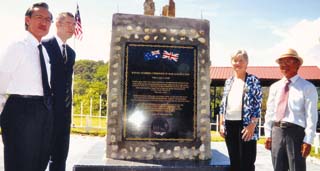Closing the chapter on last mystery
Published on: Friday, August 28, 2009

Ranau: The unveiling of the "Last Prisoner-of-war Camp Memorial here, Thursday, also "completes the last mystery surrounding the Death March." State Culture, Tourism and Environment Minister Datuk Masidi Manjun said this when officiating the ceremony attended by scores of relatives of the Australian and British POWs. The last mystery was the exact spot where the Death March ended.Thursday's ceremony around a gorgeous memorial at Pialungan, Kg Kenipir, five miles (8.3km) south of Ranau town, exposed that best kept secret for over 64 years!
ADVERTISEMENT
"If our surroundings can speak they'll tell a thousand tales," remarked Masidi, who said he was pleased that the beautiful piece of land was left untouched for more than half a century to enable Sabah to write the shared history between Sabah, Australia and Britain."The memorial unveiled at this 'The Last Camp' of the 1945 Death March symbolises the key elements of this tragic story," said Lynette Silver, who has been instrumental in uncovering the site information after 16 years of relentless research on the Death March."Embedded into the memorial's base are 1,047 rocks from the head waters of the Liwagu river which ran through the Last Camp - one for every prisoner of war who set out from Sandakan in the three death marches and did not survive," explained Lynette."The memorial itself features 183 rocks, one for each prisoner of war who died at this camp while the four rugged slabs of rock on the very top represent the four Australians who, with the help of the local people, escaped," Lynette added.
ADVERTISEMENT
Besides the names of all the 183 POWs who died here, it also has story inscriptions in Bahasa Malaysia, English and Chinese."It is fitting that this memorial overlooks the site of what truly became 'The Last Camp," she summed up. Lynette went on the say that the memorial will "always" serve as a "poignant reminder" of the unimaginable suffering and hardship the PoWs went through..
ADVERTISEMENT
"It also stands as a testimony to courage and endurance. May these words bring comfort to those who mourn the loss of someone dear," she said, adding they were spoken originally by President Abraham Lincoln at Gettysberg and are as relevant today as they were then."In a larger sense, we cannot dedicate, we cannot consecrate, we cannot hallow this ground. The brave men who struggled here have consecrated it, far above our poor power to add or detract.""The world will little note, nor long remember, what we say here, but it can never forget what they did here," Lynette concluded.What first set the stage to the Death March event in Sabah was Allied defeat in the Battle of Singapore on 15 February, 1942, when thousands of Allied troops became prisoners of war.Of these, 1,878 Australians and 641 British PoWS were sent to Sandakan to build an airstrip. It ended at Kialungan, Kg Kenipir - The Last Camp on exactly 27 August, 1945.Fifteen PoWs were still alive and well that day, almost two weeks after Japan's surrender on 14 August, when they could have been set free.But Japanese guards shot them all, including the last five Officers: Dr John Oakeshott, Dr John Picone, Dr Frank Daniels (Briton), Capt. George Cook and Flight Lt Humphrey Burgess who were initially told that they would be taken to Ranau to see the Kempeitai (Japanese Army Secret Police) to negotiate for release.However, half a kilometre down the jungle track, they were told to rest while the guards walked to the other side, leveled their rifles at them and fired.Similarly, the 10 ordinary soldiers were told to go to a village to collect vegetables. But about half a kilometre down another way, they were told they would be killed and asked what their last request was. Each asked for a cigarette and then shot through the head one by one.This is the touching story that ended the last chapter of the Death March!Land owner Dr Othman Mainudin revealed that the historic camp site may have been lost had it not been for a timely meeting with Tham Yau Kong who told him about the significance of the site during a white water rafting outing last February.Othman said the National Service authority had twice expressed interest, the first being three years ago and later offered an outright purchase. "That happened after I had met Tham and I told them straight that I was not ited Australian POWs, laid a rock each. Stay up-to-date by following Daily Express’s Telegram channel.
Daily Express Malaysia




